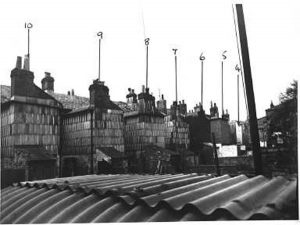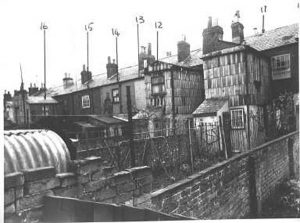Bevois Town clearance in 1959
Posted by Highfield Residents' Association on May 22, 2020 in Local History | 0 commentsTwo more pictures of the Bevois Town clearances in 1959. They both show the backs of St James’ Street houses, the first 11-16, and the second 4-10. I picked them out because they show an Andersen shelter.
The Anderson shelter was named after Sir John Anderson, then Lord Privy Seal with special responsibility for preparing air-raid precautions, immediately prior to the outbreak of World War II.
The shelters were designed to accommodate up to six people. Six galvanised corrugated steel curved panels were bolted together at the top, with three straight sheets on either side, and two more straight panels were fixed to each end, one containing the door. They were 6 feet high, 4.5 feet wide, and 6.5 feet long. They were usually buried 4 ft deep in the soil and then covered with a minimum of 15 inches of soil above the roof.
They were issued free to all householders who earned less than £5 a week. Those with a higher income were charged £7.
The shelters performed well under blast and ground shock, but in winter, they were cold and damp and often flooded in wet weather,
At the end of the war in Europe, local authorities began the task of reclaiming the corrugated iron. Householders who wished to keep their Anderson shelter could pay a nominal fee.
Many were dug up and converted into storage sheds for use in gardens and allotments. My wife’s aunt in Cleethorpes had one in her back yard. Have you got one in your garden?
(Thanks to Wikipedia, and to Southampton City Council for the first two pictures)




